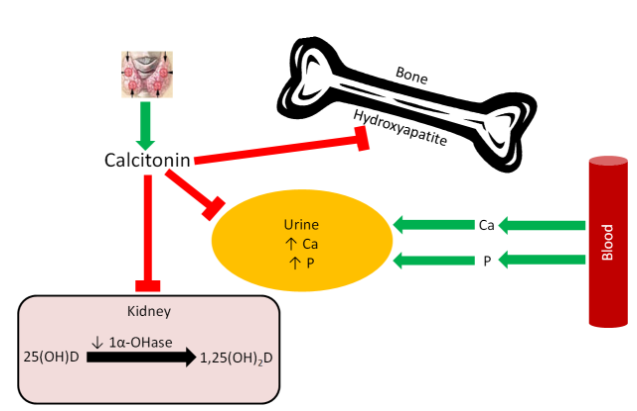12.1D: Response to High Blood Calcium
- Page ID
- 1553
In adults, it is rare for blood calcium levels to get too high. However, in infants and young children whose bodies, and thus bones, are not as large, the hormone calcitonin helps to prevent blood calcium levels from getting too high1.
Response to High Blood Calcium
High blood calcium levels are sensed by the thyroid, which releases calcitonin. This response is designed to maintain/achieve normal blood calcium levels, but also affects phosphate (phosphorus) levels. Calcitonin has three effects1,2:
- Decreases bone resorption, increases bone deposition
- Increases calcium and phosphorus excretion in urine
- Decreases 1,25(OH)2D activation in the kidney
The first effect of calcitonin is to inhibit bone resorption, thus promoting the deposition of calcium and phosphorus into bone as hydroxyapatite.

Figure 12.141 Calcitonin effect 1: increased bone deposition3
The second effect of calcitonin is to increase calcium and phosphorus excretion in urine.

Figure 12.142 Calcitonin effect 2: increased calcium and phosphorus excretion3
The third effect of calcitonin is to decrease 1alpha-hydroxylase levels, which decreases the activation of 1,25(OH)2D. As a result, the absorption of calcium and phosphorus from the small intestine is decreased, as shown below.

Figure 12.143 Calcitonin effect 3: decreased 1,25(OH)2D activation3
Overall, calcitonin inhibits the 3 actions that PTH uses to increase blood calcium levels. Thus, more calcium and phosphate are deposited into bones and excreted into urine, as shown below. This causes blood calcium levels to decrease.

12.144 Response to high blood calcium3
References & Links
- Gropper SS, Smith JL, Groff JL. (2008) Advanced nutrition and human metabolism. Belmont, CA: Wadsworth Publishing.
- Whitney E, Rolfes SR. (2011) Understanding nutrition. Belmont, CA: Wadsworth Cengage Learning
- en.Wikipedia.org/wiki/File:Il...arathyroid.jpg


